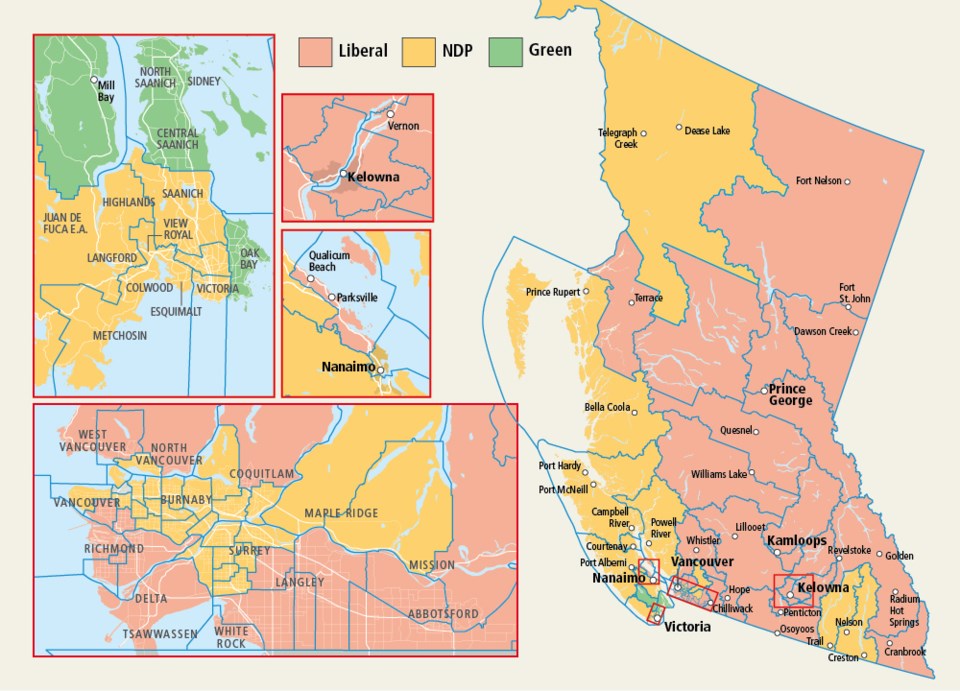 Among all the other firsts in the 2017 election, you can chalk up another paradoxical one — the closest election ever has produced one of the most regionally unbalanced wins.
Among all the other firsts in the 2017 election, you can chalk up another paradoxical one — the closest election ever has produced one of the most regionally unbalanced wins.
Regional representation is one of the key issues in putting together a cabinet, but premier-designate John Horgan scarcely has enough in his caucus to even worry about it.
All the focus has been on the closeness of the vote, and the one-seat margin in the legislature. But at the same time, it’s one of the most lopsided governments in the books.
The NDP will be taking over the government in a few days after winning 41 ridings, with all but four of them — 91 per cent — concentrated in the southwest corner of B.C. The three-member Green caucus that signed on to put the NDP over the top is all from southern Vancouver Island.
Across the vast swath of mainland terrain, from the Yukon border to Osoyoos, from the Fraser Valley to the Rockies, from the mid-coast to the Peace River Valley, the NDP has just four MLAs.
The quartet includes: Jennifer Rice (North Coast), Doug Donaldson (Stikine), Katrine Conroy (Kootenay West) and Michelle Mungall (Nelson-Creston). At least three and maybe all of them will likely be in cabinet, to balance the metro Vancouver-Vancouver Island over-representation.
The changeover is going to be a difficult adjustment for some mainland B.C. communities. Residents of the Kelowna region — “the cradle of free enterprise” in Premier Christy Clark’s immortal words — have gone decades with at least one minister to count on, often the premier (35 of the past 65 years).
Kelowna today has two cabinet ministers and a premier. After the NDP takeover in the next few days, the entire Okanagan-Shuswap-Boundary region doesn’t even have a government MLA, let alone cabinet representation.
Neither does the Thompson-Cariboo region. A Kelowna resident who develops a hankering to sit down and look a government MLA in the eye will have to drive 300 kilometres to Castlegar (three hours, 45 minutes) to make it happen.
It’s the same story in Prince George. Right now, the city and the surrounding area have four MLAs in cabinet. After the change of government, there will be only one NDP MLA in the entire North. A Prince George citizen who wants face-to-face time with a government MLA will have to drive 370 kilometres to Smithers (four hours) and look for Donaldson. Or fly to Victoria and get in line with everyone else.
That’s a wrenching change, and it’s going to take some time to get used to it. The prospect is already being greeted with alarm there. The Prince George Citizen pitched the idea Wednesday of Jobs Minister Shirley Bond imitating David Emerson’s move. (He was elected as a Liberal MP, then bolted and joined Conservative Stephen Harper’s cabinet.) A floor-crossing would give the true North the clout it deserves and has grown to expect, so the argument went.
“If [Liberals] agreed with the throne speech, which borrowed extensively from the NDP platform, what would be so hard about switching parties now?”
But it’s almost impossible to imagine. Even the editorial said: “It won’t happen, of course.”
Peace River residents are always the most remote and most sensitive to matters of inclusion. After the takeover, they’ll lose their cabinet minister (Mike Bernier) and will be one time zone away from any member of the government. The future of the Site C dam in that region will be the biggest single decision made by the new government, and it doesn’t have an MLA within 800 kilometres.
By contrast, Vancouver Island went years with only one or two cabinet ministers, due to skimpy Liberal representation. Now the Island has a premier with a pool of nine MLAs from which to pick cabinet prospects.
Building a cabinet is always an exercise in putting together a three-dimensional jigsaw puzzle. There’s gender balance, of course. Prime Minister Justin Trudeau reached 50-50 (“Because it’s 2015”) and it’s the new standard. There are aptitudes and affinities. There is seniority, ethnicity, priorities, personal relationships, old grudges and lots more to factor in.
But regional representation is always key, and it will the toughest standard for the NDP to meet.



